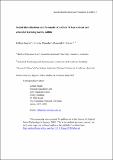Files in this item
Social identification and normative conflict : when student and educator learning norms collide
Item metadata
| dc.contributor.author | Smyth, Lillian | |
| dc.contributor.author | Chandra, Vritika | |
| dc.contributor.author | Mavor, Kenneth I. | |
| dc.date.accessioned | 2019-03-02T00:37:32Z | |
| dc.date.available | 2019-03-02T00:37:32Z | |
| dc.date.issued | 2018-06-06 | |
| dc.identifier | 252440822 | |
| dc.identifier | b08cd389-cfff-4e37-b772-d6b4967ebdf5 | |
| dc.identifier | 85042635994 | |
| dc.identifier | 000434417400001 | |
| dc.identifier.citation | Smyth , L , Chandra , V & Mavor , K I 2018 , ' Social identification and normative conflict : when student and educator learning norms collide ' , Journal of Applied Social Psychology , vol. 48 , no. 6 , pp. 293-303 . https://doi.org/10.1111/jasp.12505 | en |
| dc.identifier.issn | 1559-1816 | |
| dc.identifier.other | Bibtex: urn:34981d216f01e7aa5508d571eb41c285 | |
| dc.identifier.other | ORCID: /0000-0002-3160-3889/work/60427979 | |
| dc.identifier.uri | https://hdl.handle.net/10023/17201 | |
| dc.description.abstract | The current paper explores perceived norm conflict, social identification, and learning approaches in the applied context of higher education. Research has established the influence of identification with fellow students, and their perceived norms, on student approaches to learning. However, in the current paper, we argue that this model is not entirely ecologically valid and that students are not the only source of normative influence in the study context. In this first step to unpack these complex normative influences, we examine the next most-proximal source of normative information—the educator. In essence, we explore the ways that the normative communications of a within-field educator can also influence student learning approaches and the ways these two sets of normative effects may interact. Testing a sample of undergraduate students at Australian universities, we explore how students resolve conflicting intragroup norm sources. Findings suggest that, in line with previous literature, stronger identification with the field of study is associated with deep learning approaches, and this effect is moderated by perceived student norms such that the valence of the study norms can undermine or accentuate this effect. Novel results unpacking the effects of normative conflict suggest that this moderation effect is only present when educator norms are ambiguous and that, in instances of clearly conflicting normative messages, the identification main effect prevails. The implications and applications are discussed. | |
| dc.format.extent | 11 | |
| dc.format.extent | 596134 | |
| dc.language.iso | eng | |
| dc.relation.ispartof | Journal of Applied Social Psychology | en |
| dc.subject | BF Psychology | en |
| dc.subject | NDAS | en |
| dc.subject.lcc | BF | en |
| dc.title | Social identification and normative conflict : when student and educator learning norms collide | en |
| dc.type | Journal article | en |
| dc.contributor.institution | University of St Andrews. Centre for Higher Education Research | en |
| dc.contributor.institution | University of St Andrews. School of Psychology and Neuroscience | en |
| dc.identifier.doi | 10.1111/jasp.12505 | |
| dc.description.status | Peer reviewed | en |
| dc.date.embargoedUntil | 2019-03-02 |
This item appears in the following Collection(s)
Items in the St Andrews Research Repository are protected by copyright, with all rights reserved, unless otherwise indicated.

